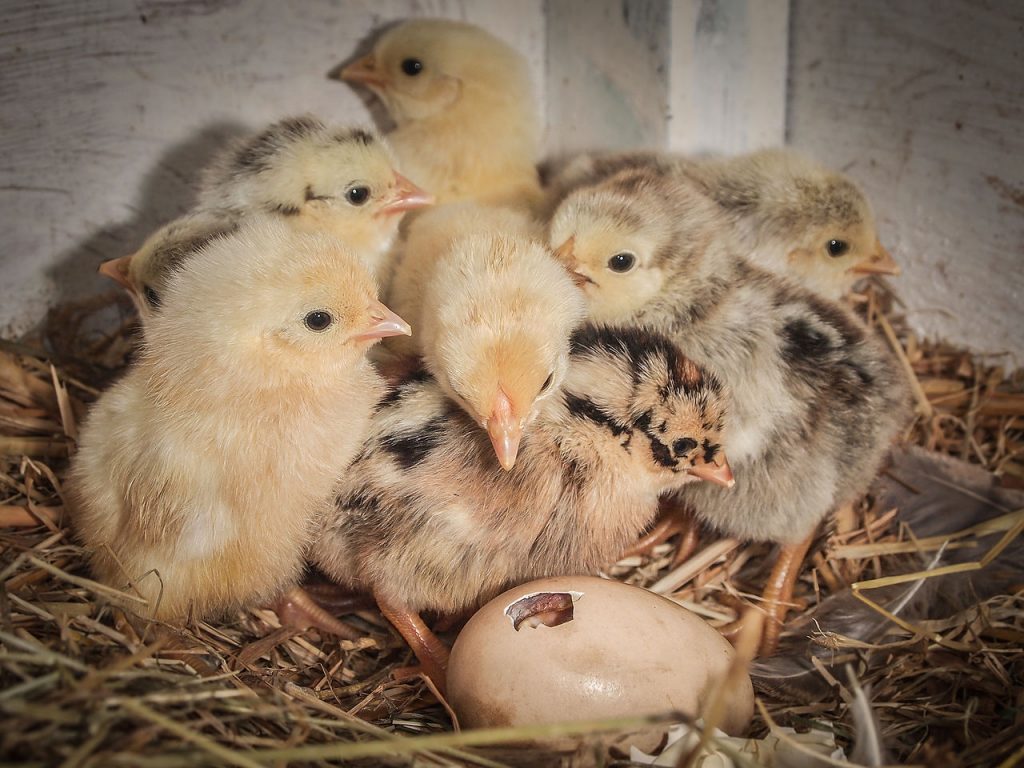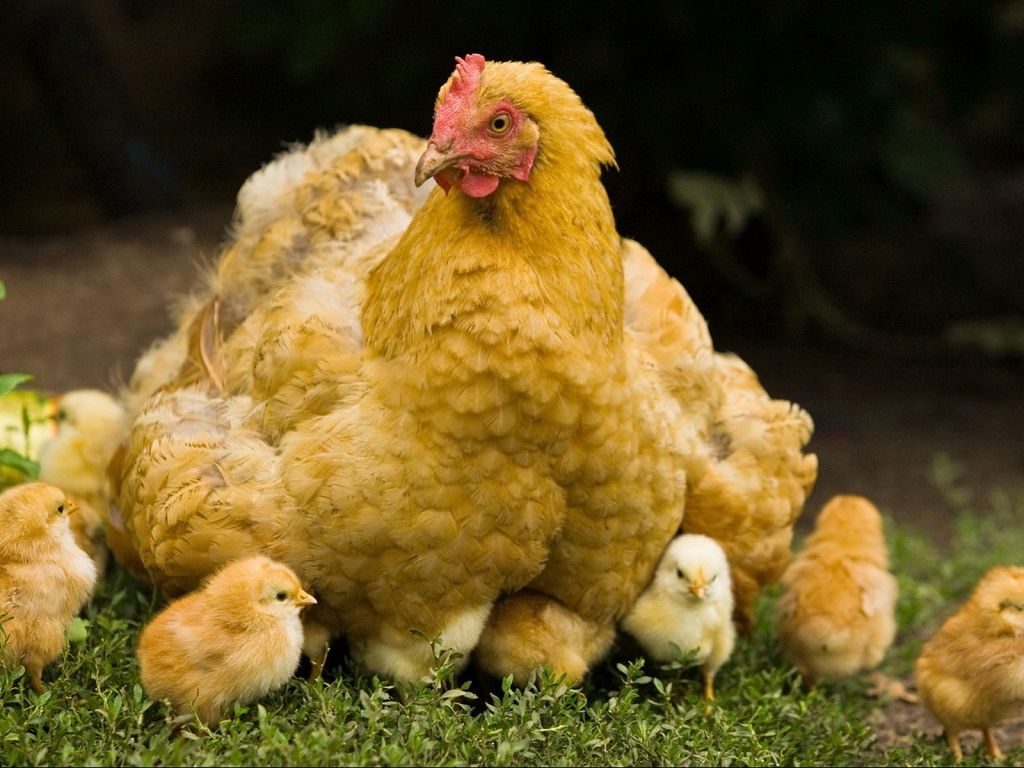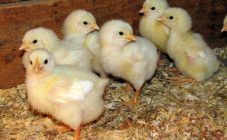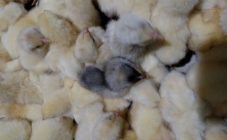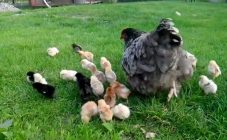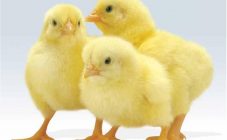Content:
Raising chickens is a rather serious task that requires a lot of knowledge and skills. You need to understand not only how long the chicks hatch under the hen, but also when the hen reared the chicks what to do next.
Chick hatching time
Chick hatching (incubation) takes on average 21 days. But do not be alarmed if the chicks decide to hatch a little earlier or a little later. This is a natural process, the duration of which may vary insignificantly. In many respects, this indicator depends on the conditions under which the eggs were stored until the moment when they were planted under the chicken.
It is best to use a chicken for such a significant process as hatching young animals, which last year showed itself well in hatching. The chicken should not be shy, sick and infected with cutaneous parasites. Parasites give the bird anxiety, and it will not be able to sit quietly on the nest.
Medium-heavy breeds of chickens with a well-developed maternal instinct are most often used as hens. Practice shows that outbred chickens are the best at hatching.
In general, the future hen can be determined by a number of indicators. The hen, in which the appropriate instinct has awakened, begins to pull out feathers from itself, cluck and collect plants for building a nest. A good hen will not voluntarily leave the nest while incubating eggs. Even if she is removed from him by force, she will definitely return, and as soon as possible.
In the process of hatching chickens, you should carefully monitor its condition. Incubation takes a lot of energy. As a rule, in order to feed the bird, it must be forcibly removed from the nest.
The hen should be created in such a way that she does not experience stress as a brood hen. It can occur if the bird is moved to a separate room, in which everything is different than in the one where it was previously. A change of scenery can make the chicken very nervous and peck at its own eggs because of this.
In addition, the nest should not be exposed to direct sunlight, the place should be shaded and not too wet. In the immediate vicinity of the masonry, it is worth placing a container with water so that the hen can drink at any time.
Periodically, you will need to change the filler of the nest. If this is not done, he will begin to rot and decay.
How chicks hatch under a hen
The first signs of egg hatching usually appear around day 19.
As a rule, we are talking about the following "symptoms":
- a quiet knock is heard inside the egg;
- a quiet squeak is heard;
- the egg starts to move (swing from side to side).
The chick hatches, thanks to the so-called egg tooth located at the end of the beak. After birth, he immediately disappears.
The hatching of the chicks itself occurs as follows:
- A crack appears in the shell, from which a chicken squeak is heard.
- A small hole appears in the shell, from which the beak is visible.
- The hole increases in center and length.
- The shell breaks and the chick hatches.
- A flagellum is separated from the shell, which is dragged behind the chicken.
Those who are just starting to hatch chicks should be aware that the entire hatching process can take from a couple of hours to a day.
Born chicks must be placed immediately in a separate cage for drying. If chicks are not collected, they may peck or move unhatched eggs, and the lives of unhatched chicks are at risk.
What to do after hatching
Most novice poultry breeders, when the brood hen reared the chickens, doubt what to do next. In fact, the correct algorithm of actions is not particularly difficult. The first thing to do after the chicks hatch and start living is to leave them with their mother for a couple of hours. After that, the quail is separated from the chickens. Babies can be put in a separate box or basket, lined with paper or thick cloth. Chickens should be kept at a temperature of +35 degrees (for this, they should be placed in an incubator or otherwise create suitable conditions for them), gradually lowering it every few days by a couple of degrees. You should stop at the indicator +20 degrees. In the absence of an incubator, a low incandescent lamp may be used for heating.
When the chick is just hatching, its initial inspection is mandatory. Healthy individuals are usually quite mobile and respond well to any external stimuli.
The average weight of an individual is about 35 g. The chick should have a soft tummy, strong legs, a large head, clean and shiny eyes, a short thick beak, wings pressed to the body, a closed umbilical cord and a pink cloaca.
Conditions for caring for black bugs with chickens
The conditions for keeping the brood should be as follows:
- the air temperature in the lower part of the house should be at least 22 degrees - chickens are very sensitive to both excessively high and too low temperatures;
- the floor must be covered with straw or boards;
- containers for water and feed should be previously disinfected; the container itself should not be deep, otherwise there is a risk that the chicks will drown;
- so that adults do not get to the tanks for water and food, a picket fence should be installed along them;
- in the process of growing chickens, pest control should be periodically carried out;
- since little chicks vitally need a brood and its constant presence, it is recommended to tie it to a peg or fence off the area in which it is with the chickens.
Some farmers start feeding chicks with antibiotics from the first days of life. But it is still not recommended to rush into this. Why - the answer is quite obvious. The fact is that in this case, the intestinal microflora cannot normalize in chicks for a long time. At first, it is recommended to feed the chicks with any finely ground boiled cereals and cottage cheese.
When the brood grows up a little, you can start to include oatmeal, millet, mixed feed in the diet. The use of old feed is not strongly recommended.
All food should be tasted by the broiler first. She will make the appropriate sounds from which the chickens will be able to understand when to start eating.
The first time to release chickens outside is two weeks after hatching. But this should be done only if the air temperature is not lower than +18 degrees.
Walking babies in more severe weather conditions are fraught with serious consequences, up to the death of young animals. Even after two weeks, they continue to love warmth and remain very demanding on the temperature regime. It is for this reason that you can only let the chicken go for a walk in warm weather.
Open-range chicks should always be able to return to the chicken coop at any time. For example, if something seems dangerous to them, they will get scared or freeze.
At first, the brood walks exclusively under the supervision of a brood hen, but already in the first month of life, the babies begin to show independence and go out into the street without being accompanied by a caring mother.
It is impractical to keep chicks under the chicken for more than 30-40 days. During this period of time, it is best to start taking certain actions to dissolve the family. Swells do not rush while caring for cubs. But as soon as they grow up, and their maternal instinct disappears, they successfully return to active egg production.
How to plant other people's chickens
Many novice poultry breeders are seriously concerned about the question of how to plant chickens to a hen. This is really important, because chickens are far from always ready to accept other people's chicks under their wing. We will try to find out how to correctly plant chickens with a hen with chickens. You should immediately make a reservation that everything must be done thoughtfully and very carefully.
Chicks should be planted following certain simple rules. So, before adding, it is necessary to do the following: place other people's chickens (for example, purchased or from an incubator) in a warm place where the brood hen did not hear them.
They need to be moved to the chicken with the onset of dusk (with blue color). As you know, in the dark, chickens do not see anything. If everything is done quietly and carefully, the bird simply will not detect the changes that have occurred.
In the morning, be sure to observe the quail to make sure that it has begun to get used to the cubs.
Best results can be achieved if the chicks are planted and are about the same age and color as their own chicks. The maximum possible age difference should be no more than three days.
It is allowed to plant other people's chickens from the second day of their life. If everything is done correctly, the chicken will take care of the chicks in the same way as for relatives.
Growing up, the chicks begin to go out for a walk with a kvochka, learn from her to hide at a special signal from danger, and tear the ground in search of worms.
After about 10 days, they stop crawling under the wing of the "mother" and just sleep next to her.
It should be noted that the period of custody of hens can vary significantly. Some stop caring for their children after a month, others graze the brood within six months.
Sometimes it is impossible to deceive the chicken, and without accepting it, it begins to peck at the chicks.As a rule, this is due to the bird's personal aggressiveness or misperception of the situation.
Solving such a problem is usually nearly impossible. Sometimes a similar problem applies not only to other people's chicks, but also to our own. A chicken may well hatch eggs and refuse chickens. At the same time, they often not only ignore the brood, but show aggression.
Answers on questions
There are questions that beginner poultry farmers often ask. We will try to give detailed answers to them.
How many chickens can be planted with a quochka
It is impossible to give a definite answer to the question of how many chickens can be planted with a kvochka. Typically, this figure depends on a number of factors, including the growing conditions for chicks with nest. Of equal importance are the weight and size of the hen, as well as the season. So, in winter, it is not recommended to plant more than 15 chicks under one hen, and in the summer, their number may well be increased to 20 units. The breed of the quail, experience and age matter. When planting chickens, it should be understood that the more there are, the sooner the mother will leave them. For comparison: a hen usually leads a company of 10 chicks from 3 months to six months, a brood of 15 chicks - from 2 to 4 months, and 25 - no more than 6 weeks.
Can a hatchery chicken breed chicks?
There is a point of view that incubator chickens cannot be brood hens. Supposedly this is due to the fact that due to the fact that they themselves were not incubated, the bird's instinct does not wake up.
This point of view has nothing to do with reality. Incubator chickens, even without a hen, can do everything that individuals bred in a natural way (with the help of a hen): eat, drink, look for and find worms in the ground and loosen everything around with their paws.
In addition, not every chicken can become a brood hen. That is why good brood hens are valued almost as much as gold among poultry houses.
Breeding and raising chickens is unlikely to be an easy task for any novice poultry farmer. But after gaining experience and (most importantly!) Strictly following the instructions of more experienced colleagues, they will be able to understand that in fact everything is not so difficult. The result will be a regularly increasing population of chickens and everything for which these birds are actually raised: eggs and meat.



